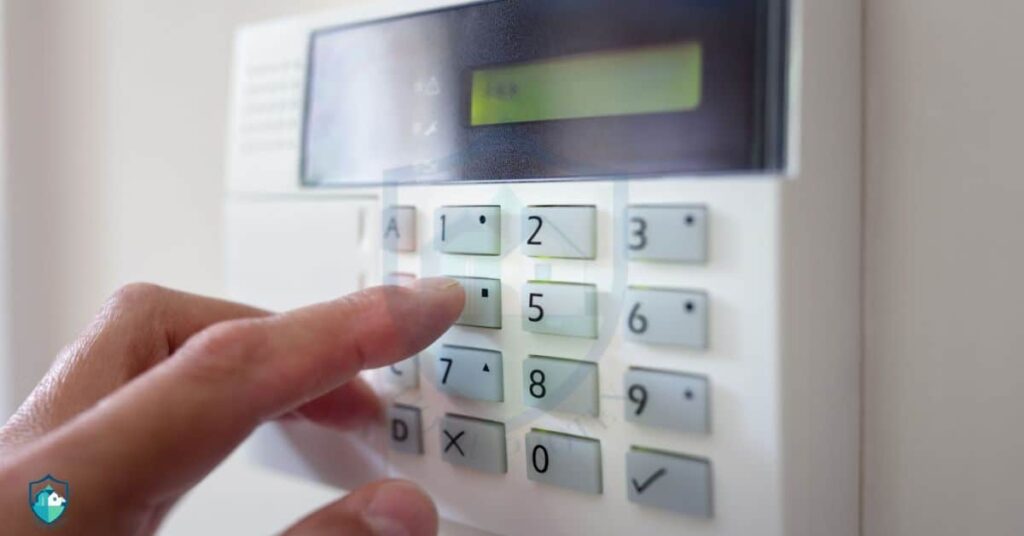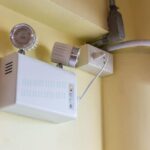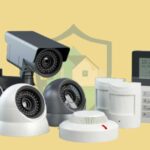Table of Contents
Have you ever wandering what is an alarm system and how does it work? Well, let me unravel this mystery for you.
An alarm system is not just a device but a protective barrier that safeguards what matters most.
Imagine the piercing sound of an alarm, the rush of adrenaline, and the sense of security it provides.
But how does it work? Let me take you on a journey where technology meets peace of mind.
In this article, I’ll delve into the intricate workings of alarm systems, from their intelligent sensors to the seamless integration with monitoring services. Are you ready to discover the secrets held by these stoic protectors?
What is an Alarm System?
An alarm system is a system that is designed to detect unauthorized entry into a building or a specific area.
It works by detecting movement or opening doors and windows. If someone enters without permission, a loud alarm will notify anyone nearby.
Here are some parts of an Alarm system and how they work:
- Control panel or hub: This is the heart of a security system. It uses radio signals to communicate with your security sensors, you, and the monitoring center. Most feature a built-in keypad or another way to arm and disarm the system manually.
- Sensors: Door and window sensors, also called contact or entry sensors, comprise two parts. They’re installed right next to each other on a closed door and window.
- When the door or window is opened or not, the two parts separate, and the sensor sends a signal to the control panel. When movement occurs in a particular area, motion sensors detect it and send a password to the control panel.
- Siren: Sirens exist in home security systems independently and are also part of other devices like the base station. Sirens often go off simultaneously with different alarms and are intended to scare intruders away or alert neighbours.
- Keypad: To activate or deactivate security systems, input a code on a keypad that is either wall-mounted or placed on a flat surface is often necessary.
- Monitoring Center: If an alarm company professionally monitors your security system, they are alerted when a security problem arises in your home.
If the control panel is equipped with 2-way voice communication, a security expert may try to talk to the homeowner through it. Alternatively, individuals can contact the emergency contact number in their account details.
Home security components keep communicating their status to the control panel; the control panel sends messages to the monitoring station (if applicable) and your smartphone. You are in control of the communication.
How Can I Install An Alarm System In My Home?
7 Steps to follow on how to install an Alarm System in your home:
- Step 1:- Determine your Needs
- Step 2:- Choose a System
- Step 3:-Install the Control Panel
- Step 4:-Install Sensors
- Step 5:-Install a Siren
- Step 6:-Connect to Monitoring
- Step 7:-Test the System
Step 1:- Determine your Needs: Decide what type of alarm system you need based on your home’s layout, budget, and security level you want.
Consider if you prefer a system monitored by professionals or a system that is do-it-yourself (DIY).
Step 2:- Choose a System: Research different alarm systems and choose one that meets your needs. You can purchase a kit and install it yourself or hire a professional to install it for you.
Step 3:-Install the Control Panel: The control panel is the heart of the alarm system, and it is the system that interacts with the sensors and activates an alarm if a secured area is breached. For enhanced security, installing the control panel in a safe location like a closet or basement is recommended.
Step 4:-Install Sensors: Door and window sensors are the most common type of sensor used in home alarm systems.
They detect movement or the opening of doors and windows and send a signal to the control panel.
Installing sensors on all entry points, such as doors, windows, and skylights, is recommended. It will enhance the security of the property.
Step 5:-Install a Siren: A siren is an integral part of an alarm system. If there is an intrusion, it can notify you and your neighbors and potentially deter any potential burglars. Install the siren in a location where it can be heard.
Step 6:-Connect to Monitoring: If you choose a professionally monitored system, you must connect your alarm system to a monitoring center.
In case of an alarm, the monitoring center will be notified, and they will contact you or emergency services as needed.
Step 7:-Test the System: Test your alarm system to ensure it works properly. Set off the alarm and make sure the siren sounds; the monitoring center gets notified.
How Are Alarm Systems Activated?
Once a sensor is triggered, the alarm systems become active. The sensor sends a signal to the alarm control panel, which activates the alarm.
The alarm can be a siren, strobe lights, or other physical alarms designed to scare off intruders and alert anybody nearby of an unauthorized entry.
The most common sensors used in alarm systems are door and window sensors.
These sensors are magnetic switches that activate an alarm signal when a door or window opens after the system is to switch to “armed” mode.
When an alarm is triggered, the control panel sends signals to a central monitoring station if the system is professionally monitored.
The monitoring center will then attempt to contact the homeowner or emergency services, depending on the type of alarm system and the homeowner’s preferences.
In addition to door and window sensors, other sensors can be used in alarm systems, like motion sensors, smoke detectors, and carbon monoxide detectors.
These sensors detect movement or hazardous conditions and send a signal to the alarm control panel, which activates the alarm.
What Are The 7 Types Of Alarm Systems?
There are different ways to categorize alarm systems, but here are the basic types of alarm systems:
- Burglar Alarm Systems: It is design to detect unauthorized entry into a home or building. They can include door and window, motion, and glass break sensors. When the alarm is triggered, a siren or strobe light can scare off intruders and alert people nearby for help.
- Fire Alarm Systems: Are designed to detect smoke and fire and alert homeowners or building occupants of potential danger. They can include smoke detectors, heat detectors, and carbon monoxide detectors. If the alarm has triggered, it can activate a siren or use a flashlight to alert individuals nearby.
- Perimeter Intrusion Detection Systems (PIDS): These are designed to detect unauthorized entry into a particular area, like a building or property. They can include sensors that detect movement, vibration, or sound. When the alarm has triggered, a siren or strobe light can scare off intruders and alert people nearby.
- Wireless alarm systems use wireless technology to communicate between sensors and the alarm control panel. They can be easier to install than wired systems and more flexible regarding sensor placement.
- Wired Alarm Systems: These use wired interconnections sensors and the alarm control panel. They can be more reliable than wireless systems and more difficult for intruders to disable.
- Unmonitored Alarm Systems: These alarms are not linked to a central monitoring station and require the homeowner or occupier of a building to take action when triggered.
- Monitored Alarm Systems: When an alarm is activated, these security systems are linked to a central monitoring station that promptly receives a notification. The monitoring center will then attempt to contact the homeowner or emergency services, depending on the type of alarm system and the homeowner’s preferences.
What Are The Three Functions Of An Alarm System?
Alarm systems have different functions depending on their type and purpose. Here are some of the parts of alarm systems:
- Detection: Alarm systems are designed to detect specific events or conditions; examples include unauthorized access entry, fire, smoke, carbon monoxides, or environmental hazards, like flooding or freezing temperatures.
- Notification: When an alarm system detects an event or condition, an alarm device like a siren, LED light or voice alert can be activated to notify the people in the building or nearby area.
- Monitoring: Some alarm systems are linked to a central monitoring station that receives signals from the system and can alert emergency services or the homeowner In the event of an alarm.
- Control: Alarm systems can control access to a building or specific region within a particular location on the building, For instance, using keypads, card readers, or biometric scanners.
- Response: Alarm systems can be designed to activate a specific reaction, for example calling emergency services or starting a fire suppression system.
- Time management: Alarm systems can schedule specific events or actions, like turning lights on or off at particular times or reminding the occupants to perform specific tasks.
The Importance of Alarm Systems at Home
Alarm systems are a necessary component of home security. Here are some reasons why having an alarm system at home is essential:
Protection of valuable belongings: An alarm system can protect valuable belongings in the home by scaring off burglars and alerting homeowners or the authorities if there is a break-in.
Deterrence of criminal activity: The alarm system can deter illegal activity by alerting authorities and increasing the risk of being caught.
Remote access and monitoring: It is possible to remotely access specific alarm systems and monitoring, providing peace of mind and allowing homeowners to monitor their property even when they are away.
Early warning of hazards: Homeowners can take action before it’s too late with the help of alarm systems that warn about potential threats such as fire, smoke, carbon monoxide, or flooding.
Speedy response: Alarm systems can speed up law enforcement dispatch in an emergency, potentially saving lives and property.
Convenience: Some alarm systems allow for convenient arming and disarming through key fobs or smartphone apps.
What Are The Features To Consider When Choosing A Home Alarm System?
When choosing a home alarm system, there are several features you must be considered.
Here are some factors to keep in mind:
The ultimate goal: To determine your plan for the alarm system; one of the benefits of having surveillance systems is their ability to prevent criminal activity and give timely alerts about potential dangers.
Installation: You must consider whether you prefer a DIY or professional installation and also factor in your plans for relocation or staying in place.
Type of system: Consider the type of alarm system, like wireless or cellular; examples of such devices include motion sensors., environmental sensors, and sirens.
Remote access and monitoring: Consider if you would like the option of remote access and tracking, either through a mobile application or a website.
Smart home integration: If you want your alarm system to integrate with other intelligent homes, consider whether it is compatible with your devices, like smoke/carbon monoxide detectors, water and temperature sensors, thermostats, and lighting.
Keypad: You have to decide whether you want a keypad to enter access codes that arm and disarm the alarm and think about where to locate it for easy access.
Emergency Dialer: Determine whether you want an emergency dialer to connect directly to emergency services dispatch centers.
Can Alarm Systems Be Activated Remotely?
Yes, alarm systems can be activated remotely in some cases. Here are some ways that alarm systems can be activated remotely:
Mobile apps: Some alarm systems have a mobile app that allows you to remotely arm and disarm the system and receive notifications when the alarm is activated. For example, the Eufy Security app will enable you to activate and deactivate the alarm remotely.
Remote access: You can set up your remote access to your home alarm panel using a project like the one described in this Instructables article. These allow you to monitor your alarm system and receive notifications when the alarm is switched on.
Panic button: Some alarm systems have a panic button that can trigger the alarm remotely. However, this feature is usually intended for emergencies and may only be available on some alarm systems.
It’s important to note that not all alarm systems can be activated remotely.
The central hub of an alarm system is the alarm control panel, and all system sensors and other equipment communicate with the board.
The committee needs a communicator to send outbound signals; not all alarm systems have this feature.
What Are The Different Types Of Sensors Used In A Home Alarm System?
Home alarm systems use sensors to detect intruders and other hazards. Here are some of the different types of sensors commonly used in home alarm systems:
1. Motion Sensors: These sensors detect the movement of people and are often used in rooms with multiple doors or windows.
2. Glass Break Sensors: These sensors detect the sound of breaking glass and can alert homeowners or authorities during a break-in.
3. Temperature Sensors: These sensors can detect extreme temperatures and alert homeowners to potential fire hazards.
4. Flood Sensors: These sensors can detect water leaks and flooding, helping homeowners to take action before substantial damage occurs.
5. Door and Window Sensors: These sensors can detect when doors or windows are opened or closed and alert homeowners to potential intruders.
6. Smoke and Heat Sensors: These sensors can detect smoke and heat, alerting homeowners to potential fire hazards.
7. Carbon monoxide Detectors: These detectors can detect dangerous levels of carbon monoxide gas, which can be deadly if left undetected.
8. Environmental Sensors: These sensors can monitor the home for fire, water leaks, extreme temperatures, and other hazards.
What Are The Benefits Of Using Temperature Sensors In A Home Alarm System?
Temperature sensors are used in home alarm systems to detect extreme temperatures within a building. Here are some benefits of using temperature sensors in a home alarm system:
Prevents freezing and bursting pipes: Installing low-temperature sensors around the home can remove the unnecessary worry over freezing and bursting pipes, which can cause severe harm and expensive repairs.
Alerts homeowners to potential fire hazards: Temperature sensors can detect extreme temperatures and alert homeowners to potential fire hazards.
Protects valuable items: The temperature sensors can protect valuable items, such as wine collections, from temperature fluctuations that can damage or spoil them.
Alerts homeowners to potential dangers: There is a low-temperature sensor that alerts homeowners when temperatures fall near that point out the concern, giving them time to react and prevent possible damage to homes, valuables, and property.
Provides peace of mind: Homeowners with a house or vacation home in cold climates will benefit from this advanced alert of temperatures sinking to potentially dangerous lows.
When temperatures start falling, homeowners can brace for the threat of cold and freezing extremes and the potential dangers they may cause.
Let that we have explored “What is an alarm system and how does it work?” We have delved into alarm systems’ components, functionality, and importance in ensuring security and peace of mind.
As responsible individuals, we can ensure safety and peace of mind by being attentive to essential details and taking necessary precautions.
It is crucial to utilize the knowledge we have gained and prioritize installing efficient alarm systems to protect our homes and businesses.
I have an article on Alarm Systems and Batteries. Click here to glance through it.




